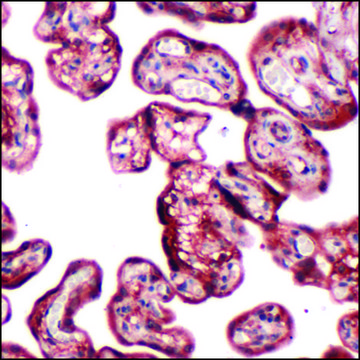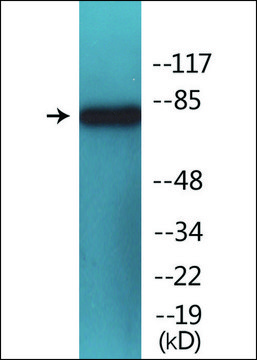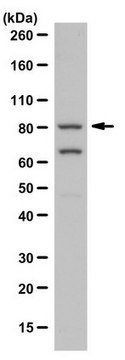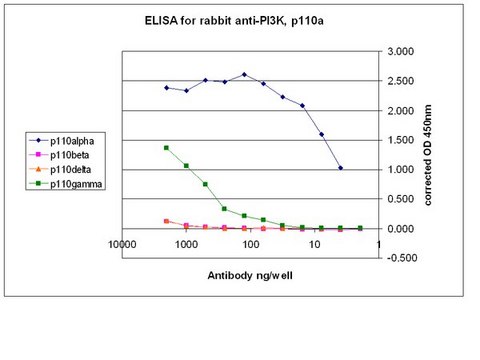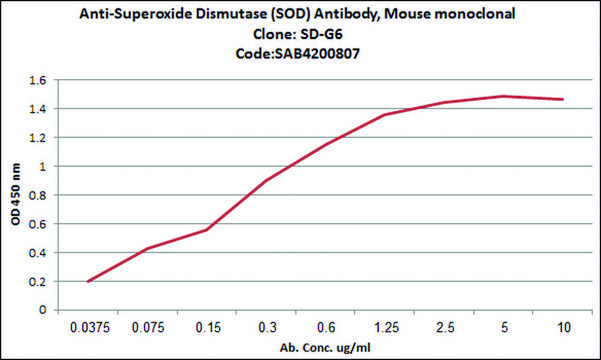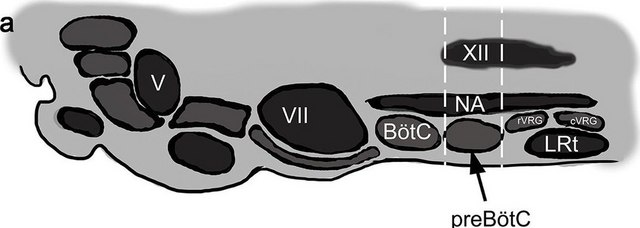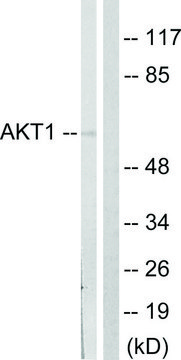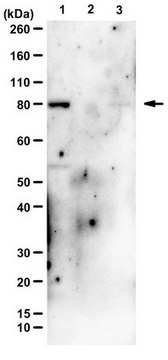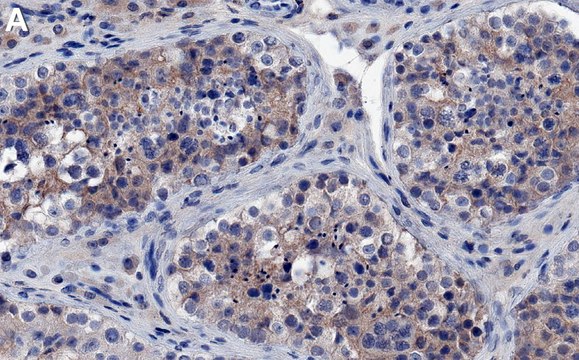GW21071
Anti-PI3K antibody produced in chicken
affinity isolated antibody, buffered aqueous solution
Sign Into View Organizational & Contract Pricing
All Photos(1)
Synonym(s):
Anti-Phosphatidylinositol-4,5-bisphosphate 3-kinase catalytic subunit β isoform
UNSPSC Code:
12352203
NACRES:
NA.41
Recommended Products
biological source
chicken
conjugate
unconjugated
antibody form
affinity isolated antibody
antibody product type
primary antibodies
clone
polyclonal
form
buffered aqueous solution
species reactivity
rat, mouse, human
technique(s)
western blot: suitable
NCBI accession no.
UniProt accession no.
shipped in
wet ice
storage temp.
−20°C
Gene Information
human ... PIK3CB(5291)
Immunogen
Immunogen Sequence: GI # 5453894, sequence 58-134
Recombinant phosphoinositide-3-kinase, catalytic, β polypeptide
Application
Anti-PI3K antibody produced in chicken is suitable for western blotting analysis at a dilution of 1:500, for tissue or cell staining at a dilution of 1:200.
Biochem/physiol Actions
Phosphatidylinositol-4,5-bisphosphate 3-kinase catalytic subunit β isoform is an enzyme encoded by the PIK3CB gene in humans. It has been implicated as a participant in signaling pathways regulating cell growth by virtue of its activation in response to various mitogenic stimuli. PI 3-kinase exhibits different isoforms and has a define family of genes encoding distinct PI 3-kinase catalytic subunits that can associate with p85. It is commonly activated in tumors. PI3K pathway is activated in tumors and most commonly through p110α mutation or PTEN deletion.
Physical form
Solution in phosphate buffered saline containing 0.02% sodium azide.
Disclaimer
Unless otherwise stated in our catalog or other company documentation accompanying the product(s), our products are intended for research use only and are not to be used for any other purpose, which includes but is not limited to, unauthorized commercial uses, in vitro diagnostic uses, ex vivo or in vivo therapeutic uses or any type of consumption or application to humans or animals.
WGK
WGK 1
Flash Point(F)
Not applicable
Flash Point(C)
Not applicable
Personal Protective Equipment
dust mask type N95 (US), Eyeshields, Gloves
Regulatory Information
常规特殊物品
Certificates of Analysis (COA)
Search for Certificates of Analysis (COA) by entering the products Lot/Batch Number. Lot and Batch Numbers can be found on a product’s label following the words ‘Lot’ or ‘Batch’.
Already Own This Product?
Find documentation for the products that you have recently purchased in the Document Library.
Lan Liu et al.
Oncology letters, 14(3), 3741-3747 (2017-09-21)
Catalpol is an effective active ingredient that functions as a diuretic and laxative, and exhibits blood sugar-lowering, liver protective, anti-aging and anticancer effects. In traditional Chinese medicine, catalpol is believed to be Yin nourishing. The anticancer effect of catalpol on
Hashem A Dbouk et al.
PloS one, 8(5), e63833-e63833 (2013-06-05)
The PI3-kinase pathway is commonly activated in tumors, most often by loss of PTEN lipid phosphatase activity or the amplification or mutation of p110α. Oncogenic mutants have commonly been found in p110α, but rarely in any of the other catalytic
Dongjin Lv et al.
Molecular medicine reports, 23(3) (2021-01-27)
Long non‑coding RNAs (lncRNAs) are involved in the occurrence and progression of numerous types of cancer. The aim of the present study was to evaluate the effect of the lncRNA maternally expressed gene 3 (MEG3) on the migration and invasion of
P Hu et al.
Molecular and cellular biology, 13(12), 7677-7688 (1993-12-01)
Phosphatidylinositol 3-kinase (PI 3-kinase) has been implicated as a participant in signaling pathways regulating cell growth by virtue of its activation in response to various mitogenic stimuli. Here we describe the cloning of a novel and ubiquitously expressed human PI
Xueliang Qin et al.
3 Biotech, 10(4), 187-187 (2020-04-08)
This study explored the effect of methyl-indole on pancreatic cancer cell viability and investigated the mechanism involved. The viability of pancreatic cells showed a significant suppression on treatment with methyl-indole in dose-based manner. Treatment with 5 µM methyl-indole suppressed Capan-1 cell
Our team of scientists has experience in all areas of research including Life Science, Material Science, Chemical Synthesis, Chromatography, Analytical and many others.
Contact Technical Service